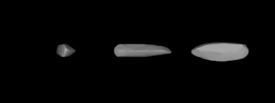Discovered by L. Kohoutek Minor planet category Apollo · NEO Aphelion 1.58 m | Discovery date 26 October 1971 Alternative names 1971 UA Discovered 26 October 1971 Orbits Sun Discovery site Hamburg Observatory | |
 | ||
Pronunciation ˈsɜr bər əs (sur-ber-uh s) Similar 3103 Eger, 2100 Ra‑Shalom, 2212 Hephaistos, 2201 Oljato, Sun | ||
1865 Cerberus (SUR-ber-uh s), provisional designation 1971 UA, is a stony asteroid and near-Earth object of the Apollo group, approximately 1.6 kilometers in diameter. It was discovered on 26 October 1971, by Czech astronomer Luboš Kohoutek at the Hamburger Bergedorf Observatory in Germany and named in 1974.
The S-type asteroid orbits the Sun at a distance of 0.6–1.6 AU once every 1 years and 1 month (410 days). Its orbit has an eccentricity of 0.47 and an inclination of 16° with respect to the ecliptic.
Cerberus is composed of 65% plagioclase and 35% pyroxene, has a rotation period of 6.804 hours, a geometric albedo of 0.220, and passes within 30 gigametres (Gm) of the Earth 7 times from the year 1900 to the year 2100, each time at a distance of 24.4 Gm to 25.7 Gm. It also makes close approaches to Mars and Venus.
The minor planet is named after the figure from Greek mythology, Cerberus, a three-headed dog that guarded the entrance to Hades, the Underworld. His capture marked the last of the twelve labors of Hercules. It is also the name of an extinct constellation, Cerberus, now contained in the eastern part of Hercules. (It should not be confused with Kerberos, a moon of the dwarf planet Pluto.) Naming citation was published before November 1977 (M.P.C. 3758).
